New Virtual Moon Atlas freeware version 7
- 1668 Rue du Tour 76160 Preaux, France (chlegrand@free.fr)
- 2Montjardins Lanuejols, France (pch@ap-i.net)
Introduction:
Since 2002, we develop a freeware to help Moon observing, to improve interest for Moon in general public, and to provide a basic tool for aggregating informations on the Moon for professionals.
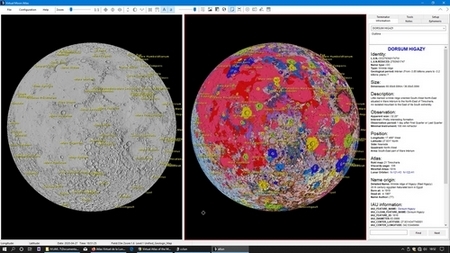
Double windows with "Kaguya / LRO Shaded relief" and "Unified geologic 2020" textures
Presentation :
VMA uses datas coming from NASA, USGS, JPL, LPI and from Dr Robinson, Binder, Gaddis, Zuber, Salamuniccar and Robbins teams, and from Kaguya, Chandrayann 1 and Chang‘é missions.
The software includes management of a complete database (Near 1 400 000 entries) of named, satellite, anonymous or human features on the Moon.
Pictures libraries presenting each named formations from LPI resources and best amateurs shootings are associated and contain more than 8 000 pictures.
VMA 7.0 is only available for Windows 7/8/10.
VMA software has been reviewed in main amateur astronomy magazines (Sky & Telecope, Astronomy , Ciel & Espace, L’Astronomie…) and downloaded more than 1 800 000 times worldwide since 2002.
French, English complete translations and others languages (GE / ES / IT / NL / …) partial translations are included.
VMA software is used by several professional organizations such as IAP Paris, Kitt Peak Observatory, National Japan Observatory, University College London, BBC Sky at night, several astronomy magazines and astronomy writers (P. Harrington, G Cannat…). Recommended by ESA (B. Foing) during SMART 1 mission, registered as educational software by French ministry for education, it has also yet been presented to professionals at 2006 & 2007 LPSC, PCC2 in 2011 and EPSC 2015 in Nantes (France) and to amateurs at 2012, and 2018 "Rencontres du Ciel et de l'Espace" in Paris. Also used in NELIOTA program by ESA / Athens Observ. and for SCHIAMACHY survey on ENVISAT DLR / ESA
Manual :
A 200 pages complete PDF and an online manual are provided.
VMA 7 Software features :
- « Map » window with tabs « Information », « Ephemeresis », « Notes», « Tools », « Setup», …
- Complete rotating Moon globe with coordinates grid and scales
- Second window opening permitting comparisons
- Map and thumbnails display on separate monitors
- Real time or choosen phase and librations display
- Orientation of the lunar disk with powerful zoom
- Formations search function starting from name
- Formations names display according to zoom power
- Orbital viewing simulation
- Integrated notepad for personal notes on formations
- Size and distance measurement tool on maps
- Context menu on right mouse click
- Maps and databases printing with captions setup
- Eyepieces and CCD cameras field simulation
- Full screen display for public videoprojections
- 3D profile of choosen formation when available
Databases :
Included databases contains more than 1 300 000 formations:
- Named formations
- Satellites formations
- Anonymous craters (From S. Robbins & G. Salamuniccar databases teams)
- Human exploration sites (Historical)
- Lisa Gaddis team pyroclastic deposits
- ALPO domes databases
- NELIOTA meteoritic impacts database
For each formation, included informations about :
- Formation geology (except historical)
- Formation localization on lunar disk
- Formation detailed description
- Detailed formation name origin
- Official IAU 2012 datas
All these databases include the “LUN / Lunar Universal Number” conceived by us and permitting quick “naming” and localization of any lunar formation more than 100 m wide (Example : AA2741S114220 > Crater located at 02,741° South and 114,220° East
Datlun : a specific database manager using menus or SQL requests for sortings and extractions on every word of all the databases (600 Mo datas).
Mapping textures :
- JPL airbrush relief with (1500 m per pixel) and without albedo (1000 m per pixel)
- Clementine and Clementine negative (200 m per pixel)
- LRO WAC (60 m per pixel)
- USGS Lunar Orbiter (60 m per pixel)
- CNSA Chang’é 2 (60 m per pixel)
- LOLA-Kaguya-Shaded (60 m per pixel)
- USGS Unified geologic 2020 (500 m per pixel)
Historical textures :
Permitting easy comparisons of pioneers works with present datas :
-Langrenus 1645
- Rheita 1645
- Hevelius 1647
- Divini 1647
- Riccioli 1651
- Cassini 1679
- Tobias Mayer 1791
- Beer & Maädler 1841
- Fauth 1936
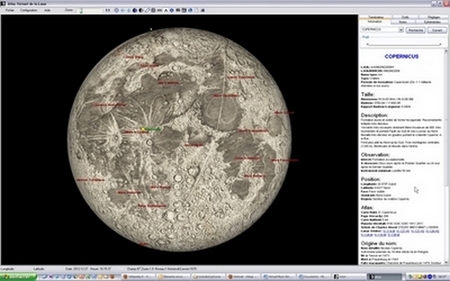
Cassini 1679 historical texture
44 scientific overlays :
Gravity, temperature, altimetric, geologic, various elements as thorium, iron, several neutrons varieties… overlays can be applied on each texture. Double window feature permits comparisons between 2 overlays
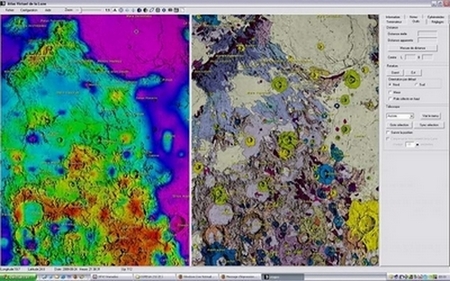
Double window with altitude & geology overlay for correlation search
Pictures libraries :
VMA includes lunar pictures libraries (Near 8 500 pictures) from :
- Lunar Orbiter Photographic Atlas of Moon
- Various lunar probes (Ranger / Luna / LO...)
- Apollo missions mapping and 70 mm Hasselblad
- Consolidated Lunar Atlas
- Lunar Astronautical Charts (LAC) and Lunar Maps (LM) from LPI
- Best amateur lunar imagers (Peach / Cathala / Wirths / Higgins / Dauvergne...)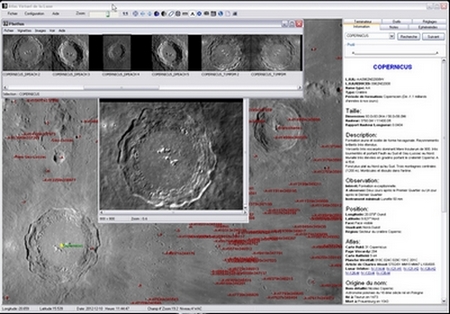
Photlun : specific pictures manager with editing possibilities permitting basic processing included.
Internet connection : 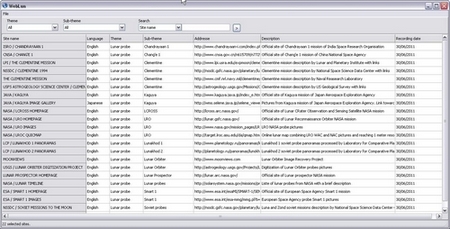
Weblun module using a special lunar Internet sites database permits connection and interactivity while using VMA.
Distribution :
VMA Pro 7 version and all add-ons collection are freeware and downloadable free from our Web site http://www.ap-i.net/avl/en/start
A SD card complete version can also be ordered on our Web site.
We maintain a discussion forum and we encourage other languages translations.
We also listen continuously to our users requests, (including professionals), trying to update the software with new useful functionalities.
Thanks :
We thank a lot all the amateur and professional persons that support the development of VMA with the permission of using datas, maps or pictures they produce. VMA wouldn't exist without them.
How to cite: Legrand, C. and Chevalley, P.: New Virtual Moon Atlas freeware version 7, Europlanet Science Congress 2020, online, 21 September–9 Oct 2020, EPSC2020-942, https://doi.org/10.5194/epsc2020-942, 2020

